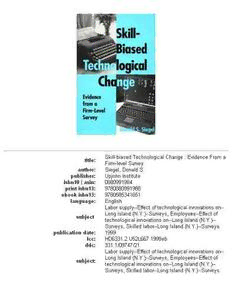Download Skill-biased technological change: evidence from a firm-level survey PDF Free - Full Version
Download Skill-biased technological change: evidence from a firm-level survey by Donald S. Siegel in PDF format completely FREE. No registration required, no payment needed. Get instant access to this valuable resource on PDFdrive.to!
About Skill-biased technological change: evidence from a firm-level survey
Labor economists generally agree that new technologies are changing the face and nature of today's workplace. Gaining ground in the new labor market are more-skilled, better-educated workers who are capable of embracing technological change in their jobs. Falling out of favor and lagging behind in wages are workers lacking the education and skills needed to acclimate themselves to new technologies. This phenomenon is referred to as "skill-biased" technological change, and Siegel provides evidence that technology adoption is associated with downsizing, skill upgrading, greater employee empowerment, and a widening wage gap. Unlike previous studies that use industry-level data, Siegel collected firm-level data on technology usage and labor composition which enable him to link the magnitude of labor market outcomes for six classes of workers to the types of technologies implemented. Specifically, Siegel examined 12 advance manufacturing technologies (AMTs), some of which were CAD/CAM systems, robotics, and just-in-time inventory systems, that were implemented by the employers surveyed. He also gathered information on Human Resource Management (HRM) strategies that accompanied the AMT installations. These data allowed him to * directly examine the labor market implications associated with the implementation of new manufacturing technologies,* explore whether changes in HRM policies that enhance employee empowerment arise following technological change, and* conduct a dissagregated analysis across the two broad classes of advanced manufacturing technologies, linked and integrated. Siegel's study has important implications for employment policy. To alleviate the well-publicized shortages of workers possessing the skills needed to adopt new technologies, he recommends that colleges and universities develop closer alliances with employers that hire their graduates and that they use an assessment center approach to evaluate educational outcomes. This will help ensure, Siegel says, that our workforce will continue to have the skills needed to complement technological change. A number of groups will be interested in the findings and recommendations presented in this book. "This evidence could be useful to managers who formulate HRM policies and strategies," points out Siegel, "and to policymakers to help target subsidies for training programs and retraining displaced workers more effectively." The findings also have implications for studies of return on investment in human capital.
Detailed Information
| Author: | Donald S. Siegel |
|---|---|
| Publication Year: | 1999 |
| ISBN: | 9780880991988 |
| Language: | English |
| File Size: | 0.66 |
| Format: | |
| Price: | FREE |
Safe & Secure Download - No registration required
Why Choose PDFdrive for Your Free Skill-biased technological change: evidence from a firm-level survey Download?
- 100% Free: No hidden fees or subscriptions required for one book every day.
- No Registration: Immediate access is available without creating accounts for one book every day.
- Safe and Secure: Clean downloads without malware or viruses
- Multiple Formats: PDF, MOBI, Mpub,... optimized for all devices
- Educational Resource: Supporting knowledge sharing and learning
Frequently Asked Questions
Is it really free to download Skill-biased technological change: evidence from a firm-level survey PDF?
Yes, on https://PDFdrive.to you can download Skill-biased technological change: evidence from a firm-level survey by Donald S. Siegel completely free. We don't require any payment, subscription, or registration to access this PDF file. For 3 books every day.
How can I read Skill-biased technological change: evidence from a firm-level survey on my mobile device?
After downloading Skill-biased technological change: evidence from a firm-level survey PDF, you can open it with any PDF reader app on your phone or tablet. We recommend using Adobe Acrobat Reader, Apple Books, or Google Play Books for the best reading experience.
Is this the full version of Skill-biased technological change: evidence from a firm-level survey?
Yes, this is the complete PDF version of Skill-biased technological change: evidence from a firm-level survey by Donald S. Siegel. You will be able to read the entire content as in the printed version without missing any pages.
Is it legal to download Skill-biased technological change: evidence from a firm-level survey PDF for free?
https://PDFdrive.to provides links to free educational resources available online. We do not store any files on our servers. Please be aware of copyright laws in your country before downloading.
The materials shared are intended for research, educational, and personal use in accordance with fair use principles.

